
III(2)_Unit_5_MassMedia_ST
.pdf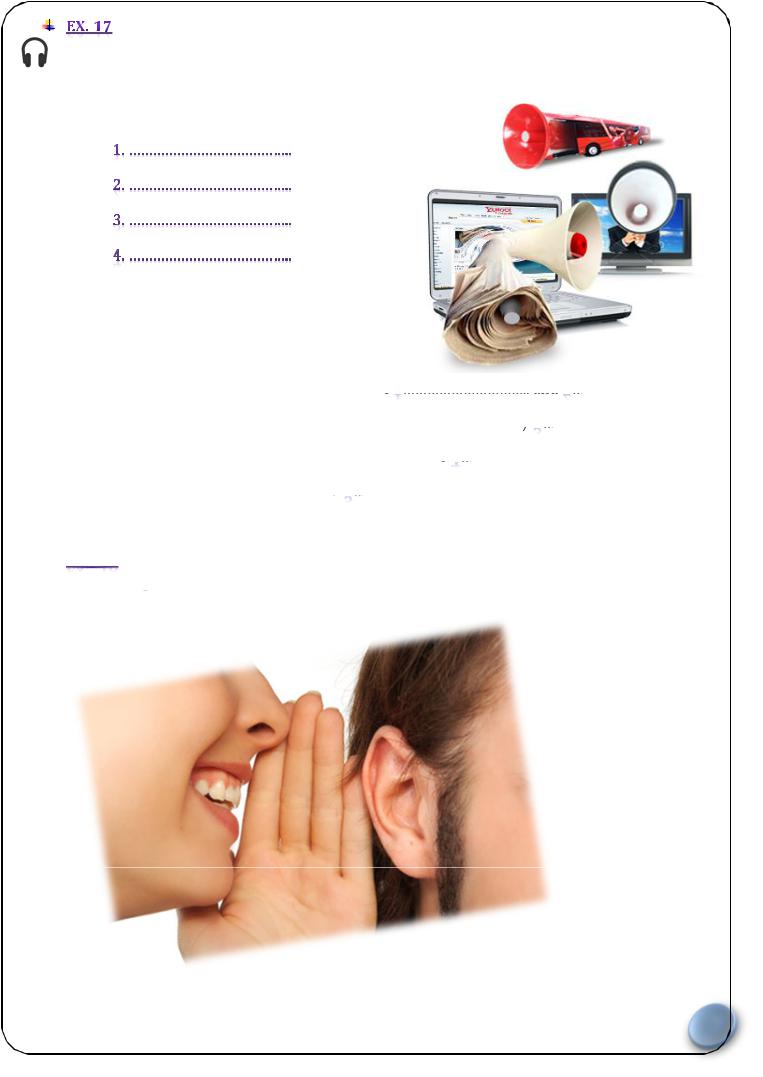

 You will hear an interview with the director of an advertising agency. He talks about the future of different advertising media. Listen and answer the following questions to show you have understood the general gist of the interview.
You will hear an interview with the director of an advertising agency. He talks about the future of different advertising media. Listen and answer the following questions to show you have understood the general gist of the interview.
1) Which four advertising media does he talk about?
2)Which three media are becoming more important?
3)Complete these sentences.
a)TV commercials less effective because of ………………………….. and
………………………….. and ………………………….. .
………………………….. .
b)Amount companies spend on Internet advertising is rising by ………………………….. .
………………………….. .
c)Period when TV commercials were very effective ………………………….. .
………………………….. .
d)“Commercial advertising”means  …………………………...
…………………………...


 With your partner, discuss what you think word of mouth means in advertising.
With your partner, discuss what you think word of mouth means in advertising.
Unit 5: Student’s Book
10
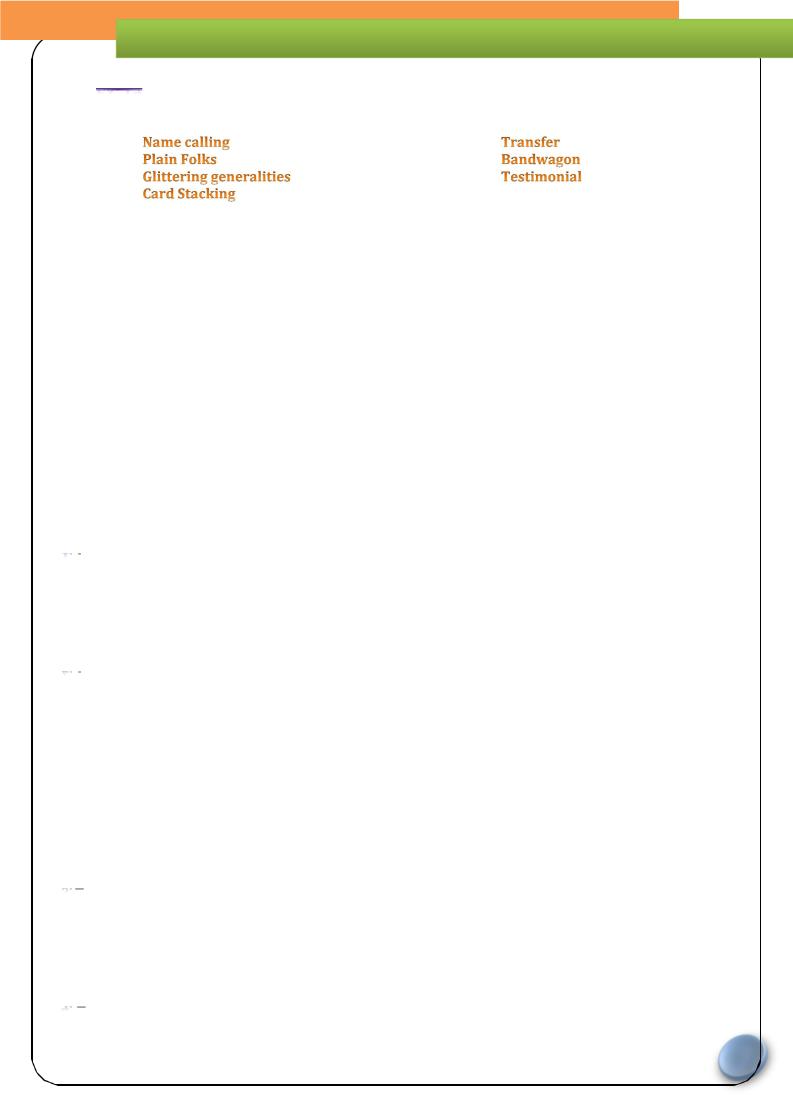
Hometask 2


 Read the text. Try to match 7basictypes of propaganda techniques
Read the text. Try to match 7basictypes of propaganda techniques
advertisers usewith their descriptions in the text.
Propaganda Techniques in Today’s Advertising
by Ann McClintock
Americans, adults and children alike, are being seduced. They are being brainwashed. And few of us protest. Why? Because the seducers and the brainwashers are the advertisers we willingly invite into our homes. We are victims, content—even eager—to be victimized. We read advertisers’ propaganda message in newspapers and magazines; we watch their alluring images on television. We absorb their messages and images into our subconscious. We all do it—even thoseof us who claim to seethrough advertisers’ tricks and thereforefeelimmuneto advertising’scharm.
Propaganda is a systematic effort to influence people’s opinions, to win them over to a certain view or side. Propaganda is not necessarily concerned with what is true or false, good or bad. Propagandists simply want people to believe the messages being sent. Often, propagandists will use outright lies or more subtle deceptions to sway people’s opinions. In a propagandawar, any tactic isconsidered fair.
Although propaganda may seem relevant only in the political arena, the concept can be applied fruitfully to the way products and ideas are sold in advertising. Indeed, the vast majority of us are targets in advertisers’ propaganda war. Every day, we are bombarded with slogans, print ads, commercials, packaging claims, billboards, trademarks, logos, and designerbrands - all forms of propaganda. Onestudy reports that each of us, during anaverageday, is exposed to overfive hundred advertising claims of various types. This saturation may even increase in the future since current trends include ads onmoviescreens, shopping carts, videocassettes, evenpublic television.
What kind of propaganda techniques do advertisers use? Therearesevenbasic types:
 ___________________________________ is a propaganda tactic in which negatively charged names are hurled against the opposing side or competitor. By using such names, propagandists try to arouse feelings of mistrust, fear, and hate in their audiences. For example, a political advertisement may label an opposing candidate a “loser,” “fence-sitter,” or “warmonger”. Ads for products may also use namecalling. AnAmericanmanufacturer may refer, forinstance, to a ‘foreign car’ in its commercial – not an ‘imported’ one. The label of foreignness will have unpleasant connotation in many people’s minds. Negatively charged information arouses hidden fears. Advertisers canalso useit by suggesting that the product can saveyou from dangerorembarrassment.
___________________________________ is a propaganda tactic in which negatively charged names are hurled against the opposing side or competitor. By using such names, propagandists try to arouse feelings of mistrust, fear, and hate in their audiences. For example, a political advertisement may label an opposing candidate a “loser,” “fence-sitter,” or “warmonger”. Ads for products may also use namecalling. AnAmericanmanufacturer may refer, forinstance, to a ‘foreign car’ in its commercial – not an ‘imported’ one. The label of foreignness will have unpleasant connotation in many people’s minds. Negatively charged information arouses hidden fears. Advertisers canalso useit by suggesting that the product can saveyou from dangerorembarrassment.
 ___________________________________. Using ___________________________________ is the opposite of name calling. In this case, advertisers surround their products with attractive—and slippery—words and phrases. They use vague terms that are difficult to define and that may have different meanings to different people: freedom, democratic, all-American, progressive, Christian, and justice. Many such words have strong, affirmative overtones. This kind of languages stirs positive feelings in people, feelings that may spill over to the product or idea being pitched. As with namecalling, the emotional response may overwhelm logic. Target audiences accept the product without thinking very much about what the
___________________________________. Using ___________________________________ is the opposite of name calling. In this case, advertisers surround their products with attractive—and slippery—words and phrases. They use vague terms that are difficult to define and that may have different meanings to different people: freedom, democratic, all-American, progressive, Christian, and justice. Many such words have strong, affirmative overtones. This kind of languages stirs positive feelings in people, feelings that may spill over to the product or idea being pitched. As with namecalling, the emotional response may overwhelm logic. Target audiences accept the product without thinking very much about what the
___________________________________ mean—orwhether they even apply to the product. After all, how cananyone oppose “truth, justice,and theAmericanway”?
Ads for consumer goods are also sprinkled with ___________________________________ .Product names, for instance, are supposed to evoke good feelings: Luvs diapers, New Freedom feminine hygiene products, joy liquid detergent, Loving Care hair color, Almost Home cookies, and Yankee Doodle pastries. Product slogans lean heavily on vague but comforting phrases: Kinney is “The Great American Shoe Store,” General Electric “brings good things to life,” and Dow Chemical “lets you do great things.”
 ___________________________________. In___________________________________, advertisers try to improve the image of a product by associating it with a symbol most people respect, like the American flag or Uncle Sam. The advertisers hope that the prestige attached to the symbol will carry over to the product. Many companies use transfer devices to identify their products: Lincoln Insurance shows a profile of the president. Corporations also use the transfer techniques when they sponsor prestigious shows on radio and television. These shows function as symbols of dignity and class. One of the varieties of transfer can be “glamour appeal” which implies that just by using the product you are automatically transferred to a specialsocialgroupwitha glamorous lifestyle.
___________________________________. In___________________________________, advertisers try to improve the image of a product by associating it with a symbol most people respect, like the American flag or Uncle Sam. The advertisers hope that the prestige attached to the symbol will carry over to the product. Many companies use transfer devices to identify their products: Lincoln Insurance shows a profile of the president. Corporations also use the transfer techniques when they sponsor prestigious shows on radio and television. These shows function as symbols of dignity and class. One of the varieties of transfer can be “glamour appeal” which implies that just by using the product you are automatically transferred to a specialsocialgroupwitha glamorous lifestyle.
 ___________________________________. The ___________________________________ is one of advertiser’s most-loved and most-used
___________________________________. The ___________________________________ is one of advertiser’s most-loved and most-used
11
Unit 5: Student’s Book
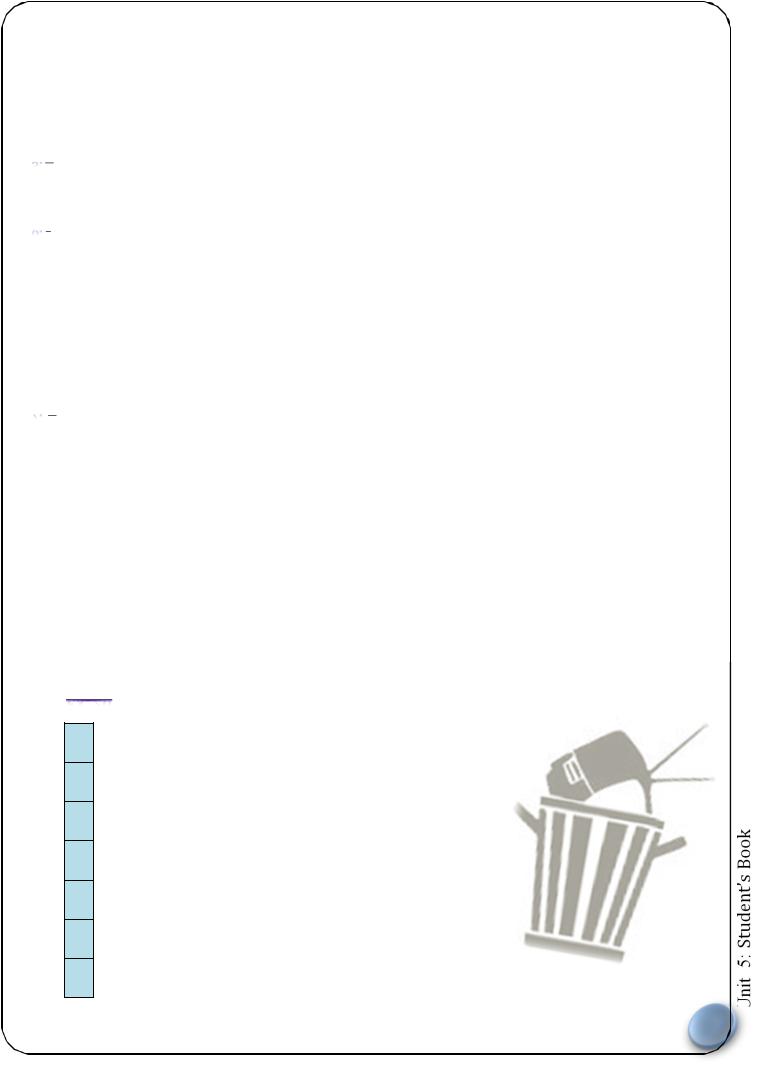
propaganda techniques. Similar to the transfer device, the testimonial capitalizes on the admiration people have for a celebrity to maketheproduct shinemorebrightly—even though thecelebrity is not anexpert onthe product being sold.
Print and television ads offer a nonstop parade of testimonials: here’s Cher for Holiday Spas; here’s basketball star Michael Jordan eating Wheaties; Michael Jackson sings about Pepsi. American Express features a slew of well-known people who assure us that they never go anywhere without their American Express card. ___________________________________
can sell movies, too; newspaper ads for films often feature favorable comments by well-known reviewers. And, in recent years, ___________________________________ have played an important role in pitching books; the backs of paperbacks frequently list complimentary blurbs by celebrities. This techniqueis also knownas celebrity endorsement.
 ___________________________________. The___________________________________approach says,ineffect, “Buy meorvotefor me. I’m just like you.” We see people making long-distance calls for just the reasons we do—to put the baby on the phone to Grandma or to tell Mom we love her. And how do these folksy, warmhearted (usually saccharine) scenes affect us? They’re supposed to makeus feel that AT&T—themultinationalcorporategiant—has thesamevalues wedo.
___________________________________. The___________________________________approach says,ineffect, “Buy meorvotefor me. I’m just like you.” We see people making long-distance calls for just the reasons we do—to put the baby on the phone to Grandma or to tell Mom we love her. And how do these folksy, warmhearted (usually saccharine) scenes affect us? They’re supposed to makeus feel that AT&T—themultinationalcorporategiant—has thesamevalues wedo.
 ___________________________________. When people say that "the cards were stacked against me," they mean that they were never given a fair chance. Applied to propaganda, ___________________________________ means that one side may suppress or distort evidence, tell half-truths, oversimplify the facts, or set up a "straw man"—a false target—to divert attention from the issue at hand. Advertisers often stack the cards in favor of the products they are pushing. They may, for instance, use what arecalled "weaselwords" These are small words that usually slip right past us, but that make the difference between reality and illusion. Theweaselwords areunderlined inthefollowing claims:
___________________________________. When people say that "the cards were stacked against me," they mean that they were never given a fair chance. Applied to propaganda, ___________________________________ means that one side may suppress or distort evidence, tell half-truths, oversimplify the facts, or set up a "straw man"—a false target—to divert attention from the issue at hand. Advertisers often stack the cards in favor of the products they are pushing. They may, for instance, use what arecalled "weaselwords" These are small words that usually slip right past us, but that make the difference between reality and illusion. Theweaselwords areunderlined inthefollowing claims:
"Most dentists surveyed recommend sugarless gum for their patients who chew gum." (We hear the "most dentists" and "for their patients," but we don't think about how many were surveyed or whether or not the dentists first recommended that thepatients not chew gum at all.)
"Sticker price $1000 lower than most comparable cars." (How many is "most"? What car does the advertiser consider"comparable"?)
 ___________________________________. In the ___________________________________ technique, advertisers’ pressure, “Everyone’s doing it. Why don’t you?” This kind of propaganda often succeeds because many people have a deep desire not to be different.
___________________________________. In the ___________________________________ technique, advertisers’ pressure, “Everyone’s doing it. Why don’t you?” This kind of propaganda often succeeds because many people have a deep desire not to be different.
In the marketplace, the ___________________________________ approach lures buyers. If we don’t drink Pepsi, we’re left out of “the Pepsi generation.”
Why do thesepropaganda techniques work? Why do so many of us buy theproducts, viewpoints, and candidatesurged onus by propaganda message? They work becausethey appealto our emotions, not to ourminds. Often,infact, they capitalizeonourprejudices and biases.Forexample, ifweareconvinced that environmentalists areradicals whowant to destroy America’s record of industrialgrowthand progress, thenwewillapplaud thecandidatewho refers to them as “treehuggers.” Clearthinking requires hard work:analyzing aclaim, researching thefacts, examining both sides ofan issue, using logic to seetheflaws inanargument. Many ofus would ratherlet thepropagandists do ourthinking forus.
Becausepropagandais so effective, it is important to detect it and understand how it is used. Wemay conclude, after closeexamination, that somepropaganda sends a truthful, worthwhilemessage. Someadvertising,forinstance, urges us not to drive drunk, to becomevolunteers, to contributeto charity. Evenso, wemustbeawarethat propaganda is being used. Otherwise, wewillhaveconsented to handing over to others ourindependenceof thought and action.


 Please, decide whether the following statements are true or false.
Please, decide whether the following statements are true or false.
1. Most propaganda techniques appeal to our minds.
2. Everybody wants to be different, hence the bandwagon technique works only with teenagers.
3. The plain folks approach suggests that youshould buythe product because everybody does so.
4. Name calling isa propaganda tactic in which positively charged names are hurled against the opposing side or competitor.
5. Propagandists simply want people to believe the messages being sent.
6. Target audiences accept the product only after analyzing what the glittering generalities mean.
7. There is propaganda which sends truthful, worthwhile messages.
12
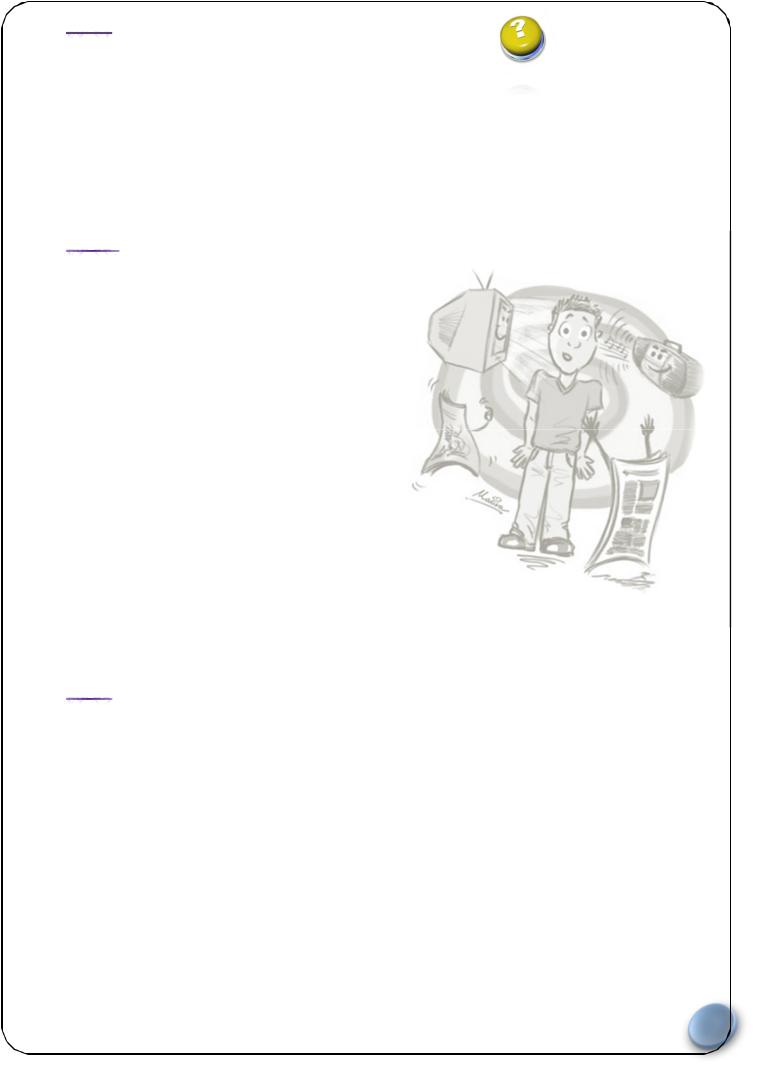


 Answer the following questions to the text.
Answer the following questions to the text.
1.Give the definition of “propaganda” in advertising.
2.Are you immune to advertising’s charm or can you be easily seduced by advertising?
3.In your opinion, what forms of advertising are you mostly bombarded with every day? Which propaganda techniquesare applied?
4.Why are testimonials often used in pitching books?
5.Do you protest against advertising or do you accept it as inevitable evil? Why do these propaganda techniques work?


 Watch the following TV commercialsor pick a commercial you like.Explain, which propaganda techniques havebeen applied in them? Note, thatmore than one technique can be used.
Watch the following TV commercialsor pick a commercial you like.Explain, which propaganda techniques havebeen applied in them? Note, thatmore than one technique can be used.
You are to prepare a brief report covering following points:
What product is advertised
Target audience
Whenis it most effective (the hours of broadcasting)
Propaganda techniques applied
Howis the message delivered?
Links:
http://www.youtube.com/watch?v=bfTyGvoUNvY&feature=fvwrel
http://www.youtube.com/watch?v=GHX2mvFVQMs&feature=related
http://www.youtube.com/watch?v=_DcjLePDHyU&feature=related
http://www.youtube.com/watch?v=fyxJwYV1a6s&feature=related
http://www.youtube.com/watch?v=GT86iWiH2mI&feature=related
http://www.youtube.com/watch?v=8EF_bWsBliw
http://www.youtube.com/watch?v=5zkYFs6ZqOc&feature=related


 Vocabulary Practice (teacher’s instruction)
Vocabulary Practice (teacher’s instruction)
Unit 5: Student’s Book
13
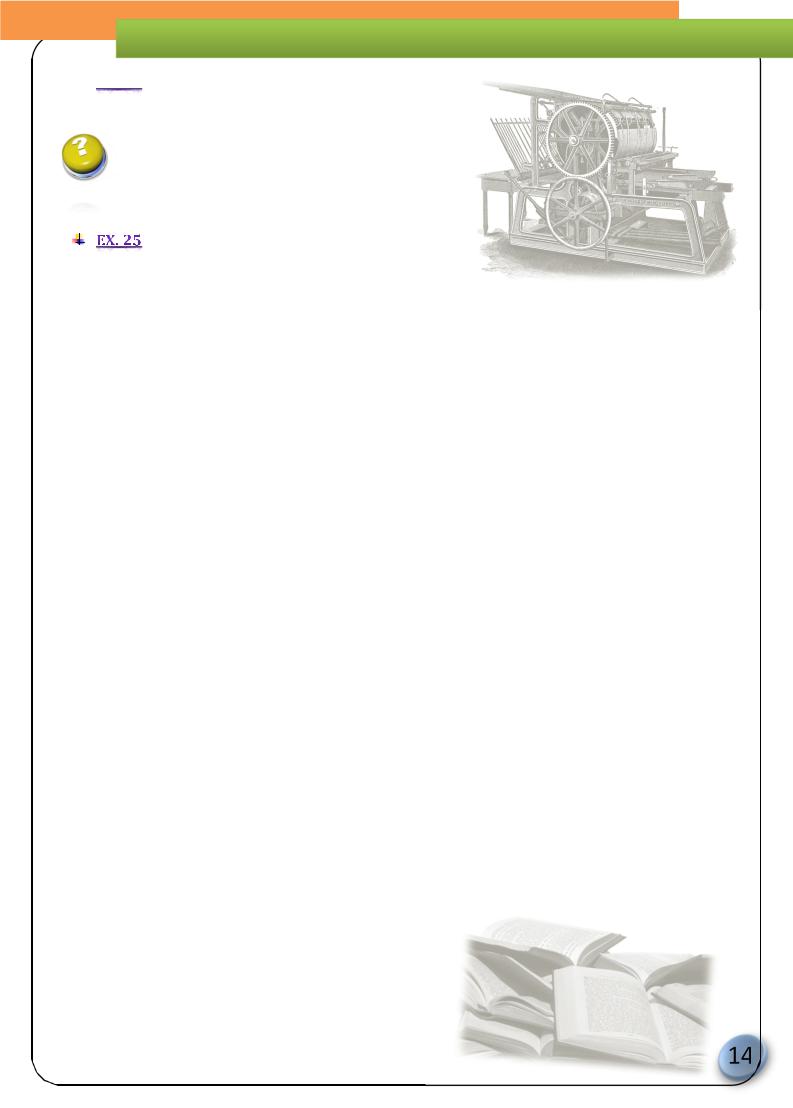
Theme Two: Mass vs. Social Media


 Answer the following questions.
Answer the following questions.
1.What types of mass media do you know?
2.What are the main functions of massmedia?
3.How do you understand the distinction between mass media and social media? Give some examples.

 Read the text below. Do you agreewith the author's reasoning?
Read the text below. Do you agreewith the author's reasoning?
How would you finish the text.
Future of Print Media
The Future ofNewspapers
Newspapers have been concerned about their future for some time now. While the number of adults reading newspapers and the number of papers sold each week are higher than ever before, the growth of newspaper readership has not kept up with the growth of population in this country. Young people, especially, are not turning to newspapers. Young people who seek news for years have turned to television, which has done a superficial job, for the most part. And now comes along the Internet. The Internet gives us up-to-the minute news the way radio has been able to do, but the Internet lets you filter out the news you don't care about and only receive the news you do care about. This certainly begs the question: Are the print media dying? University professors and professionals ask the question at theirconventions and conferences. But by some definitions, the newspaper is one of the most interactive media around. That paperproduct just isn’t electronic.
•You can start reading them at the beginning, middleorend.
•You can stop anytime you want, and start again whenyouwant.
•There are indexes to help you jump around to the spots youwant.
•Youcantakeit almostanywhere.
•Youdon’tneed batteries.
Thirty years ago the experts were predicting that newspapers as we knew them would be dead “in 10 years.” We'd all be receiving news from videotext machines (a primitiveform of computer). Well, oday, theexperts are not predicting that newspapers are going to go away, but they willchange. Readers willlook to both the Internet and print editions of the paper for news. Newspapers have a strong brand recognition when it comes to news and readers who want reliablenews willgo to themedia they trust.
But print media that go online will not succeed simply by shoveling their old content onto the World Wide Web. To make money they will have to provide value added
services, such as search capabilities for old stories, search capabilities forclassified ads,and originalWeb content.
In actuality, there is a greater demand today for news and information. Those who are trained to reliably gather information from a variety of sources, synthesize or make sense of it, and repackage it for dissemination in a variety of formatswillbeingreat demand . . . AREingreat demand. New media, which includes the World Wide Web, is one of the fastest growing and highest paying career fields for the news media. The vast majority of newspapers in the country now haveweb sites, though most of them are stuck in the paradigm of creating content for their print editions and then simply moving it over to the World Wide Web. They all know they need to be there, but are confused on how to profit from being there. Only a few newspapers havecomecloseto breaking even.
The Future ofMagazines
Magazines are thriving today. True, the general interest magazine has gone by the wayside (see the Magazines and Newsletters lecture). But the special niche magazines are catching on. Advertisers are anxious to target their ads to specialized audiences. Some print magazines are even taking advantage of technology to deliver the same magazine with specialized advertising for targeted geographical regions. It won't be long until the technology will allow them to target advertising specifically to each advertiser. Magazines are also finding a niche in new media, too.WhetherontheWorld WideWeb or oncompact disk, 'zines are popping up . 'Zines are magazines that exist in electronic form only and can contain sound and animation that print cannot. They may cover a tightly focused topic and may exist for one issue only. Or they may be "high gloss" magazines, such as Slate or Salon or The Onion. You can find an index of online 'zines at a www.online-magazine.com/guides.htm.
And, of course, like the newspapers, magazines are experimenting with moving theirprint content online.
The Future ofBooks
………
Unit 5: Student’s Book
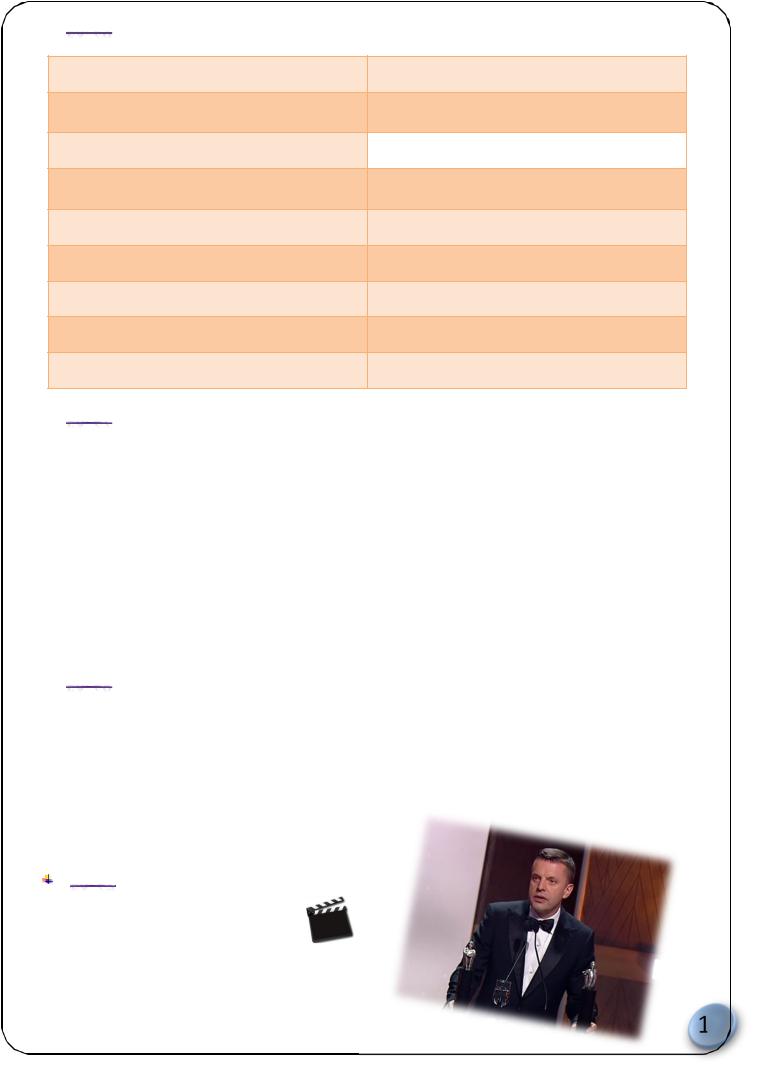


 Findin the text English equivalents to the following words.
Findin the text English equivalents to the following words.
1. читатели
2. самый последний (об информации, новостях)
3. необращать внимания, пропускать 
4. заслуживающий доверия, достоверный
5. дополнительныеплатныеуслуги
6. содержание
7. распространение (информации)
8. новостныеСМИ
9. процветать


 Paraphrase using words from the previous exercise.
Paraphrase using words from the previous exercise.
1)They are hoping that the paper will have quite agreat number of readers.
2)You can depend on the postal service here. It's very good.
3)It is still unclear whether dotcom companies will continue to do well inthe long-term future.
4)News of the disaster was spreading quickly.
5)The graphics are brilliant. It's just a shamethere’s not much informationon thesite.
6)Net users can move unwanted emails to a special folder with software.
7)The role of the media providing newsin shaping public opinion is very important.
8)For the latest information visit the German National Tourist Office website at http://www.germany-tourism.de.


 Paraphraseand translate.
Paraphraseand translate.
1)Young people, especially, are not turning to newspapers.
2)This certainly begs the question:Are the print media dying?
3)There are indexes to help you jump around to the spots you want.
4)Newspapers havea strong brand recognition…
5)In actuality, there is a greater demand today for news and information.
6)The vast majority of newspapers in the countrynow have web sites, though most of them are stuck in the paradigm of creating content for their print editions.

 Listen to L. Parfenov’s speech
Listen to L. Parfenov’s speech
and summarizeits main points.
15
Unit 5: Student’s Book
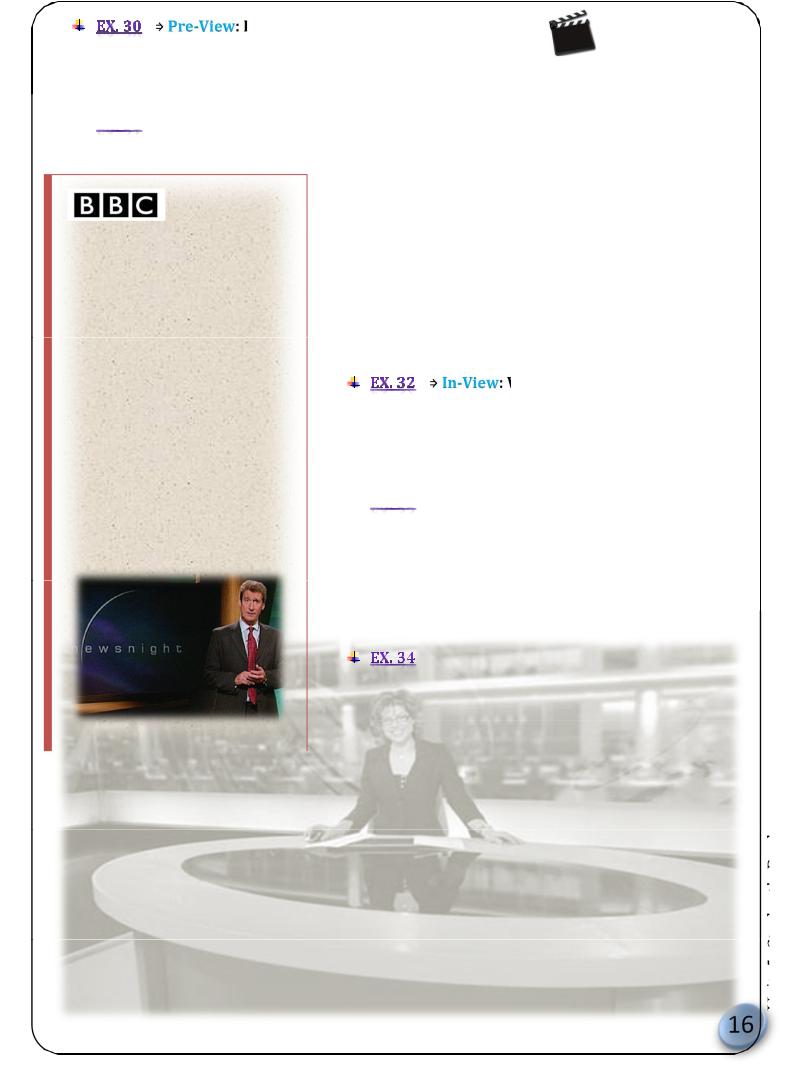
|
Discuss the following questions in pairs. |
1.Do you watch the news? How would you describe the newscasters: funny or serious?
2.Why do you think TV viewers enjoy seeing newscasters and reporters making mistakes?


 Look at the programme informationin the box below and find there words/phrases 1-8.
Look at the programme informationin the box below and find there words/phrases 1-8.
The FunnySide of the News
The Funny Side of … is a BBC series that looks at the things that can go wrong on TV, from talent shows to wildlife programmes. Tonight it takes a look at TV news. As serious as news can be, mistakes and blunders are unavoidable. And with the introduction of 24-hour rolling news, mistakes have become more frequent and more visible with newsreaders stumbling over their words and endless technical hiccups. From the autocue malfunctioning to the wrong guest being brought into the studio for an interview, disaster is waiting to strike at any moment.
1.hesitate or make mistakes when you are speaking ( ……………… )
2.happen suddenly and cause damage (………………)
3.a small problem with a machine (………………)
4.continuous (………………)
5.a machine that shows the words the TV presenter has to say (………………)
6.a mistake (………………)
7.go wrong (for a machine) (………………)
|
Watch thevideo and make notes |
on which blunder:
you find the funniest
you didn’t find funny or don’t understand


 Watch the video again and numberthe blunder in the order they appear in the programme.
Watch the video again and numberthe blunder in the order they appear in the programme.
Malfunctioning equipment
People stumbling over their words
The wring guest
An accident on a live programme

 Which accident do you think was the most embarrassing for the newscaster?
Which accident do you think was the most embarrassing for the newscaster?
Unit 5: Student’s Book
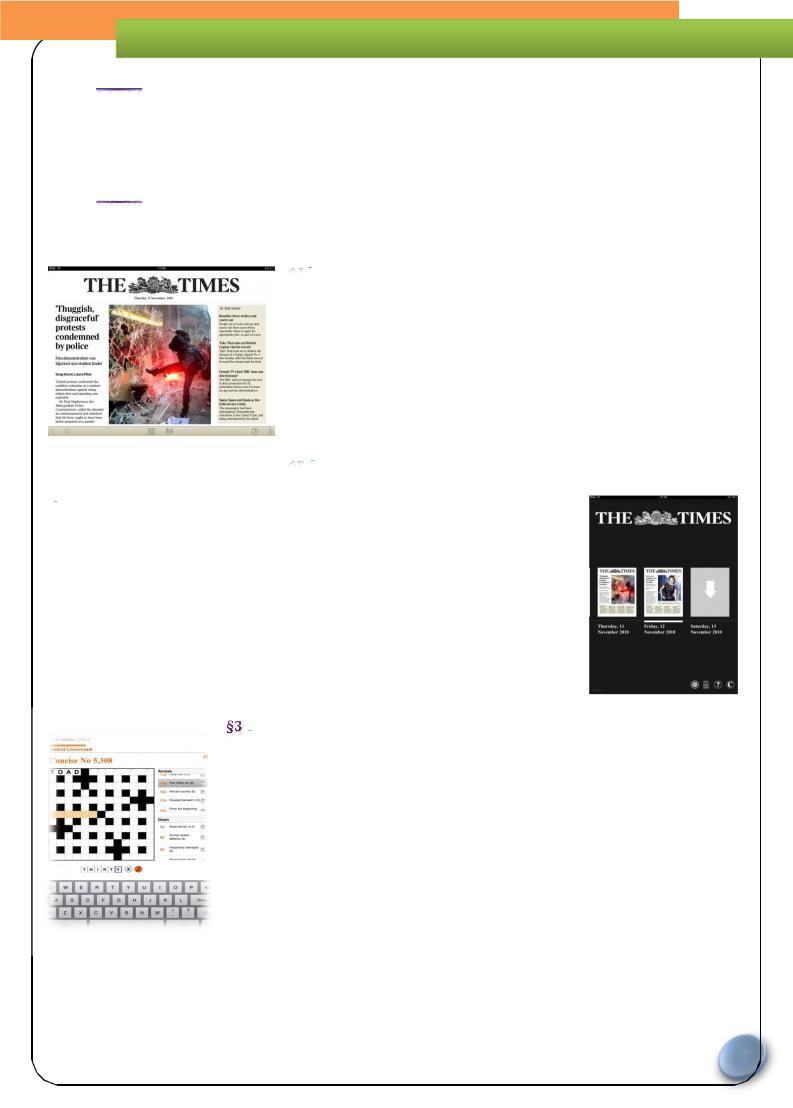
Hometask 3



 Think aboutthe following questions (makenotes for classreporting).
Think aboutthe following questions (makenotes for classreporting).
1.Do you read newspapers, magazines etc.?
2.Do you prefer a print version (of newspapers, magazines, books) or a digital version?
3.Do you agree that the future of media is digital?



 Read the text below. Is your experience similar to the author’s?
Read the text below. Is your experience similar to the author’s?
Newspapers vs iPad apps: a week-long test
 I love newspapers. Frequently my desk is piled so high with yellowing copies of The Times and The Guardian. In the interests of full disclosure, I even worked on newspapers for more than five years. So giving up my daily fix of newsprint-smudged fingers is a big deal for me.
I love newspapers. Frequently my desk is piled so high with yellowing copies of The Times and The Guardian. In the interests of full disclosure, I even worked on newspapers for more than five years. So giving up my daily fix of newsprint-smudged fingers is a big deal for me.
Yet, for the past week I’ve done just that. I’ve stopped handing over my £1 every morning to Mr Govani in the shop next to the station, and downloaded the latest copy of The Times and The Daily Telegraphon the iPad before setting off to work, to test whether it’s really possible – desirable, even – to switchfrom print to screen. Here’s what I found.
 THE DAILY ROUTINE
THE DAILY ROUTINE
The first obstacle to reading newspapers on an iPad is that it needs a little forethought: a rare commodity in my house first thing in the morning. Instead of simply picking up my rucksack and bowling out of the door, I now have to fire up the iPad and download the latest editions of the newspapers before I kiss the kids goodbye. ThePC ProiPad is Wi-Fi only, so downloading over 3G isn’t an option.
My prime concern before embarking on this test was that the newspapers wouldn’t be ready to download before I left the house at 7am each morning. Happily, new versions of both The Times and The Telegraph have been sat waiting for me to download each morning, and they only take a minute or two to download on my relatively sluggish 4Mbits/sec broadband, so they barely disrupt my dash for the door.
 THE COMMUTERTEST
THE COMMUTERTEST
Normally I arrive at my station with five or ten minutes to spare before boarding my train, and spend those idle moments thumbing through the sport section. That’s no problem on the iPad too – the screen is plenty bright enough, even in direct sunlight. Except, that is, when it rains. While I’m entirely nonchalant at the prospect of a few spatters of rain pock-marking the paper copy of The Times, the iPad has to remain snugly tucked away in my rucksack at the slightest hint of Sussex drizzle.
There are problems at the other end of my commute, too, when I hop on the Tube. While I’m perfectly accustomed to snatching 10 minutes’ worth of reading in between someone else’s armpit on a ridiculously packed Tube train, there’s no way you can whip the iPad out
and start thumbing through the columns if you haven’t got a seat. Unlike the paper or even the Kindle, it can’t be held comfortably in one hand, and the thought of dropping it as the train pulls to a sudden halt is too painful
to bear. So in terms of sheer convenience and portability, I’m afraid the paper still wins.
17
Unit 5: Student’s Book
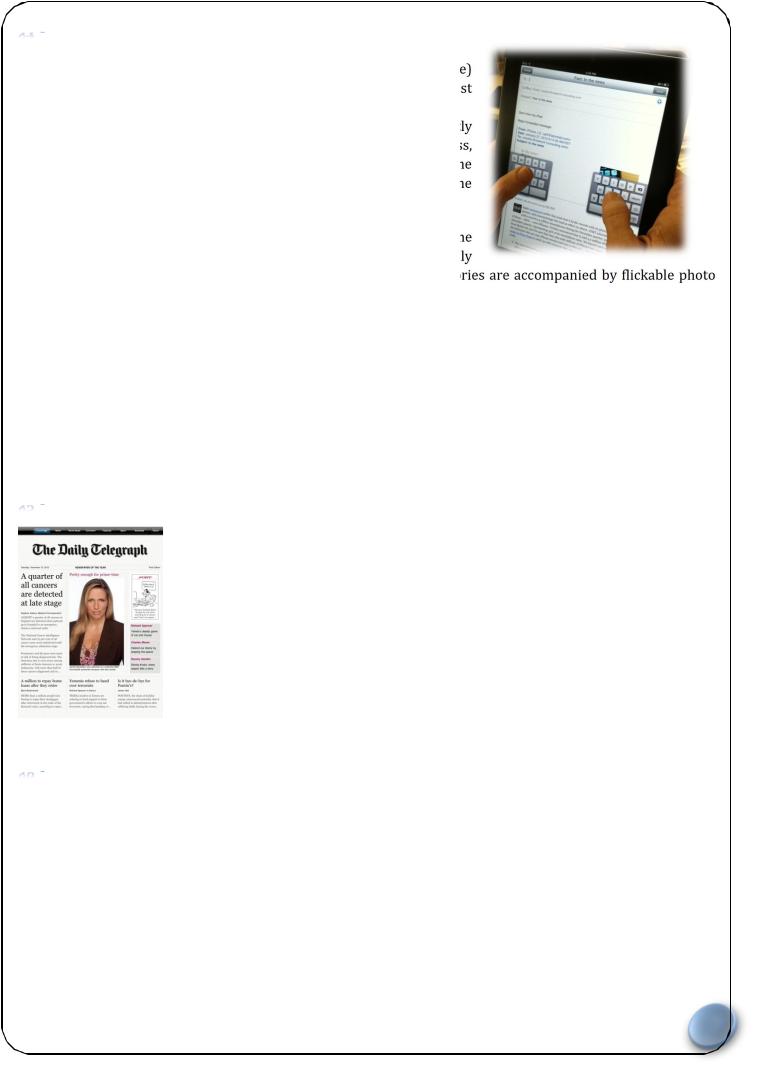
 THE READING EXPERIENCE
THE READING EXPERIENCE
The Times, with its ambitious/foolhardy (delete according to prejudice) plans to actually make people pay for the news, is by far the most impressive.
It has the look of a newspaper, and just like the paper it’s perfectly possible to thumb the pages from back to front, taking in news, business, features and finally ending on sport. You can also jump straight to th section or article you want, using the navigation bar at the foot of page.
But this isn’t a straight, PDF facsimile of the paper on the newsstand: content has been reformatted into a series of elegant, finger-friendly templates that genuinely make the newspaper a pleasure to read.
galleries, interactive infographics or occasional video clips. There are interactive versions of the cryptic and concise crosswords that you can fill in withthe onscreen keyboard.
The novelty may wear off, but it has genuinely made me want to spend more time reading the newspaper. Usually on the way back from work I’ll watch a DVD or play a game on my laptop; this week I’ve been flipping out the iPad and browsing features or reading columns that I’d almost certainly have ignored in the paper.
That’s not to say the reading experience is flawless. The background on The Times app is so brilliantly white it’s actually quite difficult to read for long periods of time without nuking your retinas. I’ve actually had to manually adjust the iPad brightness to delay the onset of epilepsy. It’s also prone to the odd crash, especially when you try and jump to another section usingthe nav bar.
 THE COST
THE COST
So how much would it cost to swap the newspaper for its iPad brethren? Well, of course, you’re going to have to spend at least £429 on an iPad if you haven’t already got one, which is more than enough to buy you a year’s subscription to a newspaper on its own.
The Times iPad edition currently offers a free 30-day trial, after which it’s £9.99 for 30 days’ access, which can be bought direct from iTunes. Considering the newspaper itself costs £1 from Monday to Friday and £1.50 on Saturday, that’s a saving of at least 50% (when you take the lack of a Sunday newspaper out of the equation). It’s cheaper still if you sign up for The Times and The Sunday Times websites for £2 a week, as you
get full access to the websites andthe iPad edition as well.
 THE VERDICT
THE VERDICT
So would I forego my daily newspaper for the iPad apps? Yes, I absolutely would.
Considering I already spend at least £7.50 a week on daily and Sunday newspapers, the fact that I could save myself £5.50 a week by signing up for a Times subscription means I’m already half-way to paying off the cost of an iPad over the course of a year.
Yes, the iPad’s not as hardy on a rainy platform or sardine-tin Tube train, but in other ways it’s far more convenient: no queue at the corner shop, no death stare when I hand the newsagent a £20 note because I’ve not got any change, not even any need to get out of bed to read the newspaper on a Saturday morning. Bliss.
Adapted from http://www.pcpro.co.uk/blogs/2010/11/13/newspapers-vs-ipad-apps-a-week-long-test/
18
Unit 5: Student’s Book
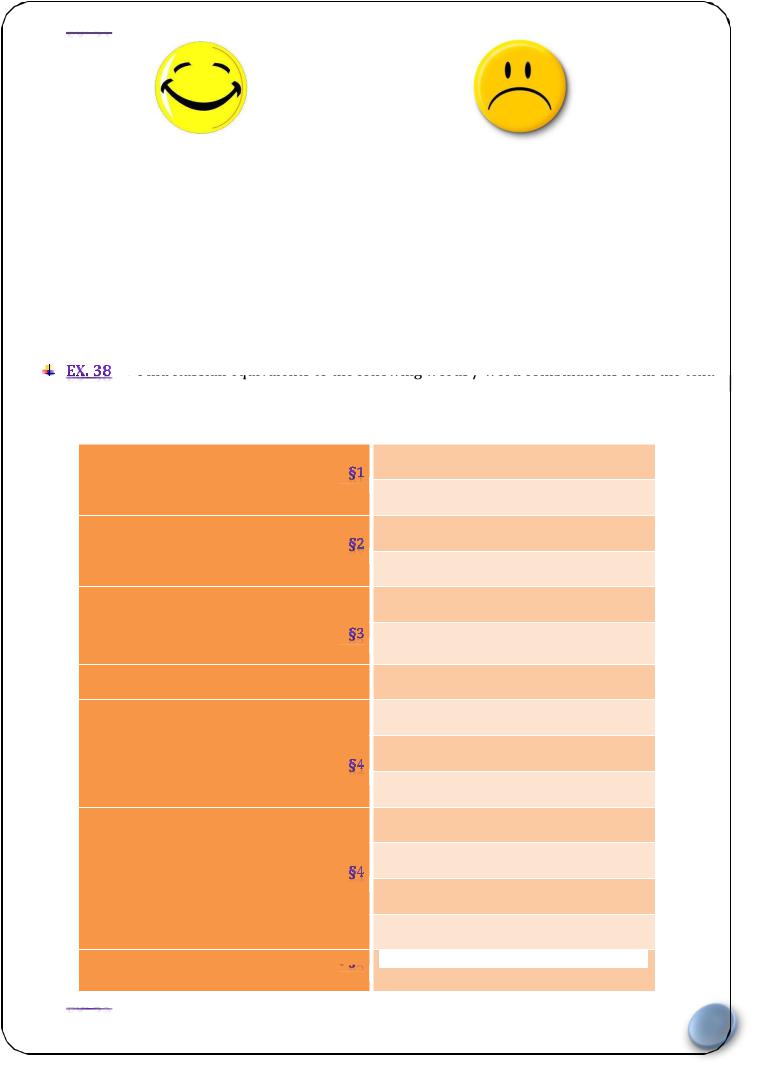



 Make lists of advantages anddisadvantages of the iPad version ofThe Times.
Make lists of advantages anddisadvantages of the iPad version ofThe Times.
____________________________________ ____________________________________
____________________________________ ____________________________________
____________________________________ ____________________________________
____________________________________ ____________________________________
____________________________________ ____________________________________
____________________________________ ____________________________________
____________________________________ ____________________________________
____________________________________ ____________________________________

 Find Russian equivalents to the following words/ word combinationsfrom the text.
Find Russian equivalents to the following words/ word combinationsfrom the text.
Word |
|
Russian equivalent |
|
|
|
|
|
|
my desk is piled so high with … to switch from printto screen
download the latest editions of … my prime concern was …
thumbing through the sport section/columns
my commute
finger-friendly
accompanied by flickable photo galleries fill in with the onscreen keyboard prone to the odd crash
to buy a year’s subscription to a newspaper
a free 30-day trial sign upfor The Times
get full access to the websites
forego daily newspaper for the iPad apps




 Vocabulary Practice (teacher’s instruction)
Vocabulary Practice (teacher’s instruction)
19
Unit 5: Student’s Book
